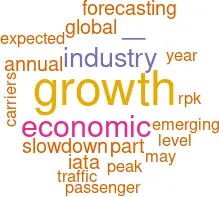Economic and aviation cycles: Are we at the peak yet?
December 2019


After an unprecedented eleven years of above-trend growth in the airline industry there are signs of demand weakness emerging that might give support to those who think it is time for a slowdown. The IMF in its October World Economic Outlook again downgraded its estimate for GDP growth in 2019 — by 30 basis points — to 3.0%, noting that the pace of economic activity remains weak and pointing out that the momentum in manufacturing has fallen to levels not seen since the global financial crisis. An uptick to 3.5% in 2020 is expected, however.
The rise of protectionist attitudes, particularly in the USA, and the trade war with China are likely to mean that the top four economic areas (US, China, Japan and Euro area — which between them account for half of global GDP) will see economic growth moderate further in the medium term. A large part of the organisation’s forecast for global economic uptick in 2020 comes from a recovery in emerging markets that had slowed in 2019, notably Brazil and India, or those emerging markets which had been under severe stress (such as Venezuela, Argentina and Iran) which may have bottomed out. It also highlights the severe risks on the downside — and the recent geopolitical tensions in the Gulf between Iran and the USA is a case in point — and that the outlook is “precarious”.
Meanwhile, IATA, in its biannual review of airline economic performance, published in December, downgraded its forecasts for annual profits in the industry. It suggests that the industry could end up with an operating profit of $42.5bn (10% lower than its April forecast and representing a margin of 5.1%) down from $45.9bn in 2018 on revenues up by 3% and traffic (in terms of RPK) up by only 4.2%. If so, this would be 30% down from the recent peak level of profitability achieved in 2015. At the net level it is forecasting profits of $25.9bn, a margin of 3% and equivalent to $5.70 per departing passenger.
During 2019 passenger demand moderated. For the past five years industry RPKs had been growing at an annual rate of 7-8%, well above the historic long term trend. In July, the northern hemisphere’s peak season, the industry registered growth of a just 3.7% (and 2.7% on international services) and since then growth in RPKs has remained muted. But capacity growth has also been a little slow, and IATA is forecasting that global passenger load factors will have risen to a record 82.4% worldwide.
Part of the reason behind this slowdown lies with the grounding of the 737MAX fleet and the lack of deliveries of new aircraft from Boeing (see following article). Part may be due, particularly in Northern Europe, to the “Greta” effect, increasing awareness of the environmental impact of aviation and the growth of the flygskam movement. A large part may be due to reduced consumer confidence. IATA is forecasting a further slowdown in 2020 to growth in RPK of only 4.1%.
Cargo has suffered this year. Total freight traffic in RTKs is expected to be down by 3.3% with cargo yields down by a further 5% year on year.
On a regional basis, there appears to have been a slowdown in growth rates in all areas. With domestic Chinese traffic registering annual growth of “only” 8.5% for the ten months to October, down from 12.5% in 2018, RPK growth among carriers in the Asia Pacific region is expected to halve to an annual 4.5%.
Growth among the Middle East carriers meanwhile has slumped to 2.6%, with the carriers in the region paying their passengers 5% of their revenues at the operating level to fly.
IATA is forecasting reasonable levels of profitability for the North American and European airlines but notes that under its forecasts the industry as a whole, with returns on invested capital of only 5.7%, has returned to the normal state of destroying shareholder value.
Source: IATA
Source: IATA
Source: ICAO, IATA